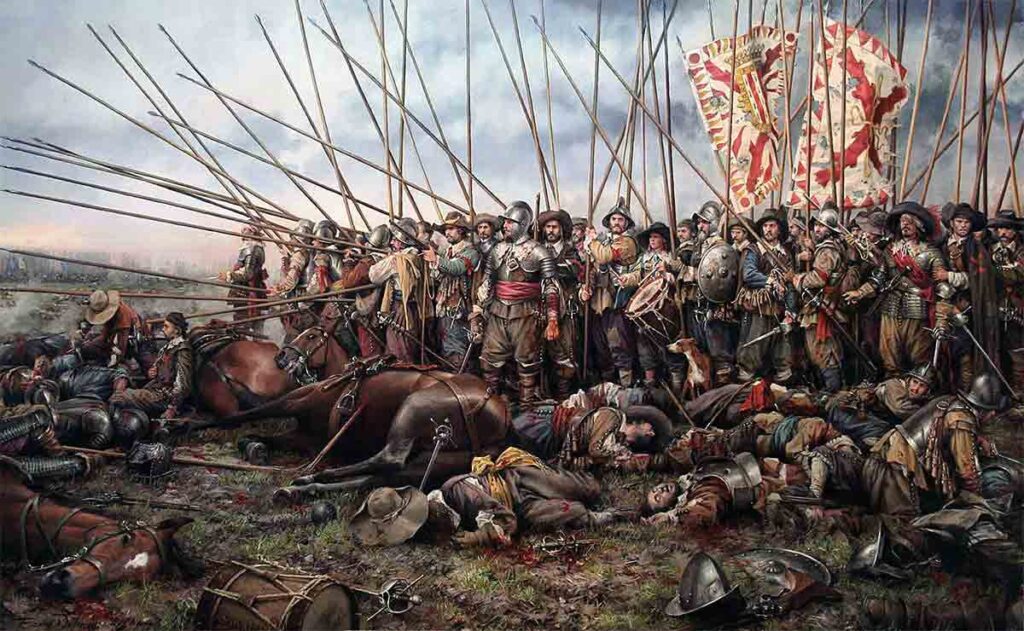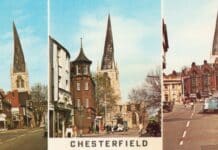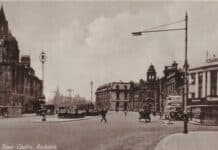EDDIE BRAZIL dons his breastplate and tassets and goes in search of the phantom armies, which are still slugging it out on England’s Haunted Battlefields.

Haunted Battlefields
The Ancient Rider: Wheathampstead 55 BC
When Roman Emperor, Julius Caesar, invaded Britain in 55 BC, he was confronted by a coalition of British tribes under the leadership of Cassivellaunus, King of the Catuvellauni, the most powerful tribe at the time.
Following a series of bloody battles, the British were forced back to the Catuvellauni capitol at Wheathanpstead in Hertfordshire, where they were defeated by Caesar’s legions.
Today, it is still possible to see the remains of the capitol and get a feel for the bloody chaos which took place over 2000 years ago. You may also get a glimpse of one of the combatants.
In recent years, accounts of a ghostly, lone warrior riding a horse through the fort has been reported.
He rides almost naked and is described as being painted in blue woad. Witnesses claim that they have seen the long haired, moustached horseman gallop through the trees and then disappear in to the banks of the forts ramparts.
The Forgotten Battle: The Mystery of Brunanburh 937 AD
If ever a battlefield needed ghosts it is Brunanburh. It may well be haunted, it might not, but for such an important battle in British history, its phantoms are sorely needed. Let me explain.
Brunanburh reads like a name straight out of Tolkien, or an episode from Game of Thrones
In 937, the Anglo Saxon King Aethelstan invaded the north of a still embryonic England.
He already controlled much of the south, west and the Midlands. However, he sought to enlarge his domains by confronting the Danes who ruled in York, and the Vikings Pics and Scots who held sway in the lands up to the river tweed on the border with modern day Scotland.
In 937, the army of Aethelstan met the combined forces of Vikings, Irish, Picts and Scots at Brunanburh. Thousands were slain on both sides, but the English were victorious.
Aethelstan was magnanimous in triumph. The Danes fled overseas, but he allowed the Scots, Picts Irish and Welsh to keep their lands if they paid him homage. Today the borders between the British countries have remained the same since that momentous clash. Its outcome defined modern Britain
Yet there is a puzzle to Brunanburh. That it occurred is without question. Yet, over a thousand years later no body knows where it took place. Historians and academics have debated its true location without success, and it remains a mystery.
Probably the only way that its site will be revealed is if its ghostly soldiers and the sound of sword and shield, together with the Anglo Saxon battle cry of “Out! Out! Out!” is once again heard in a remote northern English field.
The Towton Bloodbath, Towton 1461 AD
The War of the Roses was fought between the two rival royal houses of York and Lancaster between 1453 and 1487. Both parties laid claim to the English throne, and were prepared to shed the blood of thousands to achieve their goal. Many battles were viciously contested, but none more so than that which occurred at Towton in Yorkshire in 1461.
Towton was the bloodiest battle ever fought in England. The clash of arms took place during a snow storm on Palm Sunday, and by the end of the day up to 30,000 bodies littered the field, slain in murderous hand to hand combat. The victory allowed the Yorkist, Edward IV to ascend the throne and depose the Lancastrian Henry VI.
Towton is a location full of ghosts. It is said that every seven years on the anniversary of the battle, if the weather is snowy, then one will see and hear a replay of the clash. Other accounts say that if you visit the River Cock at the so called, Bridge of Bodies, where so many Lancastrians were cut down in flight, one will hear the moans and cries of help of the dead.
Such tales would seem to be folklore generated by terrible and bloody events. However, is it possible that Towton is indeed a truly haunted battlefield?
Not too long ago, three friends, who were interested in paranormal research, visited the battlefield to hold an all night investigation. During their vigil they had the uncomfortable feeling that they were being followed by an unseen presence. They also heard the thudding sound of a horse stomping its hooves.
They were glad to see the light of dawn. Before they left the site they posed for a phone camera selfie. The resultant image shocked them all, for it showed the three friends smiling, yet in the background is the unmistakable figure of a man on horseback who was definitely not there when the picture was taken.
Was this the ghost of one of the 30,000 men who perished on that Palm Sunday in 1461?
Roundheads vs Cavaliers, Edgehill 1642 AD
The English civil war was fought between 1642 and 1651 between the forces of the English Parliament and the supporters of King Charles I. At the time there was no standing army in Britain, and the battle was contested by almost, amateur militia men and trained bands.
The first major engagement of the war was in October 1642 at Edgehill in Warwickshire. Both armies slugged it out to an inconclusive draw, and by nightfall they limped away to lick their wounds and fight another day.
A few months later, after the dead and wounded had been removed from the field, shepherds returned to the site to graze their sheep. Much to their shock and alarm they are said to have witnessed a replay of the battle taking place in the skies above Edgehill.
Looking up they saw and heard the clash of steel and the sound of musket and cannon as the two phantom armies once again engaged in battle. The Shepherds fled in terror and soon the whole neighbourhood was holding vigil at the battlefield to see the ghostly soldiers in the sky.
In January 1643, a pamphlet “A great wonder in heaven” was published detailing the ghostly goings on. Soon word of the phenomena reached King Charles who sent commissioners to investigate the reports. Incredibly, they too witnessed the battle, and even identified some of the soldiers taking part.
Today, even though there are no reports of people seeing the ghostly clash of arms, the sound of screams,canon and thunder of hooves have been heard on the anniversary of the battle.
The Haunted Airfield, The Ghosts of Bircham Newton
Many people consider that Britain’s most haunted places are our castles, stately homes and ruined abbeys. Yet, for me, there are other equally paranormal locations which are far more eerie, atmospheric and probably still more psychically active.
The numerous airfields and RAF stations which were constructed during the second World war to take the fight to Nazi Germany are now places of haunting beauty and solitude. After the war many were returned to farmland, yet there are those which survived with their runways, hangars and out buildings still intact.
To stand on an abandoned former RAF station in the cold winter dawn and look out towards the distant misty runways, or the cobwebbed and deserted control tower is a wonderful eerie sensation. It is easy to hear the far off drone of a returning bomber or snarling Spitfire. But when the sounds approach there is nothing there to account for them.
It is no wonder that many of these airfields are said to be haunted. The RAF paid a deadly price for their courage. 50,000 personal were killed and it would seem that their ghosts are still trying to return to base. Accounts of the apparitions of airmen in flying gear have been reported from many stations seemingly because they are unaware that they are dead.
Bircham Newton airfield in North Norfolk was constructed during the first world war, but was used during WW11, as a base for coastal command. The base was retained after the war and became a training centre and college for the building industry. Today it is the airfield squash court which is believed to be haunted by three airman who crashed their plane returning from a mission.
One day in December 1970 a technician from the training centre was playing squash alone in the old court. He had locked himself in to the court, and was therefore surprised when he heard footsteps and then a heavy sigh sound from the viewing gallery behind. He turned and was astonished to see the ghostly figure of a RAF airman in World War 2 flying gear staring down on him. As the technician watched the figure slowly vanished. Terrified he fled from the court.
Following the experience it was decided to leave a tape recorder in the empty court at night to see if it could up any ghostly sounds. What was heard when the investigators played back the tape astonished them.
The unmistakable sound of an aircraft drone was heard along with voices and noises which seemed to be coming from a old wartime hangar. Further investigations revealed that the ghost may well that of a 1940s serviceman who died when his play crashed returning from a mission. Today Bircham Newton is still active with paranormal phenomena.







